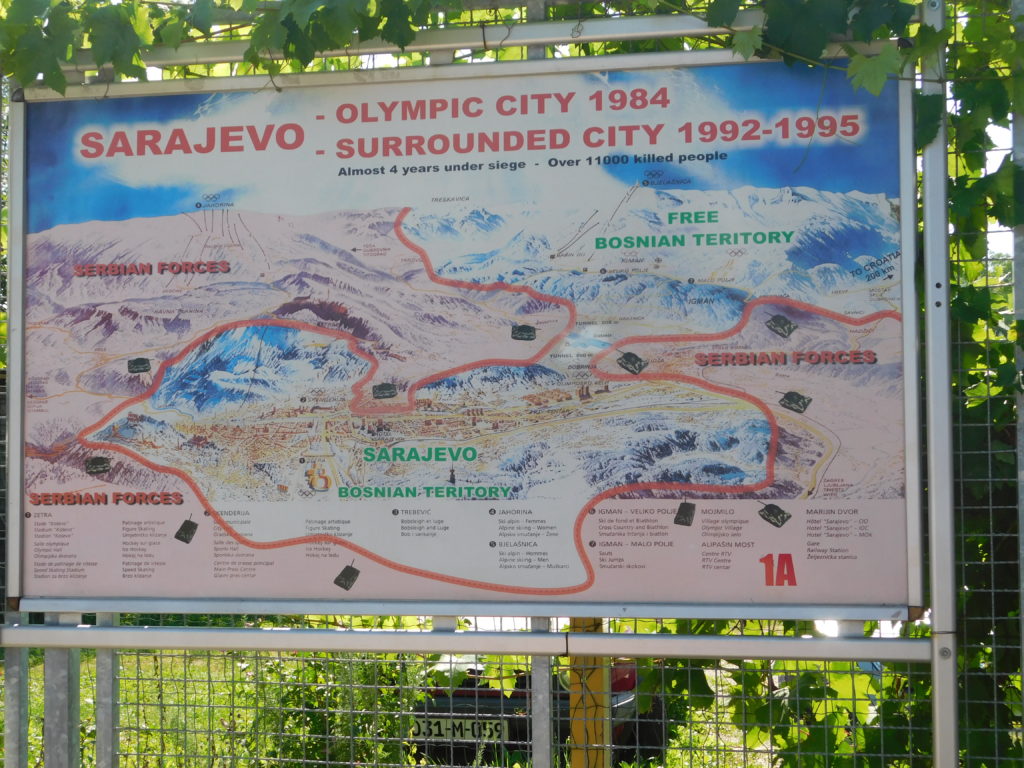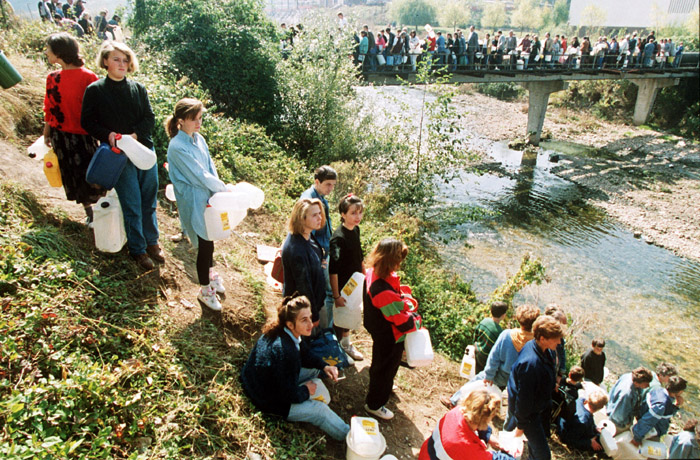The Siege of Sarajevo.
As a reminder, here’s how the Serbian forces (JNA) surrounded Sarajevo:.

On 2 May 1992, Bosnian Serb forces established a total blockade of the city blocking the major access roads, cutting off supplies of food and medicine, and cutting off the city’s utilities – water, electricity, and gas. They also arrested President Izetbegović detaining him at the airport. Although the JNA and Army of the Republika Srpska (VRS) forces were better trained and better armed than their counterparts in the Army of Bosnia and Herzegovina (ARBiH), the latter far outnumbered the former and were able to rebuff every attempt by the combined Serbian forces to take the city.
Throughout the month and a period of intense negotiations, the UN Security Council passed Resolution 758 on 8 June demanding that the Sarajevo Airport be included in a Sarajevo security zone and open for humanitarian aid. Still, the second half of 1992 and the first half of 1993 are considered the height of the Siege of Sarajevo. The UN, despite the presence of the United Nations Protection Force (UNPROFOR), did little to prevent the numerous atrocities that continued well into 1994 and 1995 but their control of the airport kept it open to humanitarian airlifts by late June that, together with the Tunnel (which we will visit anon), likely saved the city.
Fortunately, it’s not my job to make you feel as though you, like both our city guides, lived for four years in a city under siege. And frankly, if words could do that, it would require a more talented writer than I. Still, the war and the siege continue to permeate the very essence of Sarajevo and certainly inform the totality of this day, so unfortunately, I have to include descriptions of some of the horrors that rained down on this city and these people to the best of my ability while striving to attain some balance.
Because they failed in their efforts to capture Sarajevo, the Serbs concentrated their efforts to weaken the Bosnian capital by tightening the blockade and by continual bombardment from at least 200 reinforced positions in the surrounding hills. Most estimates say that the Serbs hit the city with an average of 329 shells per day during the siege or an average of one shell every four and a half minutes all day, every day for 1,425 days. Even if you were somehow in a part of the city that wasn’t targeted by the Serbian army, the sounds of the shells alone would have hit your ears like this:.
and done so every five minutes every day for nearly four years.
On 1 June 1993, Serbian mortar shelling killed 11 people and wounded 133 more who were watching a soccer game.
On 12 July, the shelling killed another dozen people. While it wasn’t this particular group, this photograph by Mikhail Evstafiev shows that in this instance the victims were simply waiting in line to get water.

Just east of the site of the Eternal Flame five mortars landed at about 11:00 on the morning of 28 August 1995 in the Markale or Marketplace. They killed 43 people and wounded 75 more. This blast was the stated reason for the NATO air strikes that began shortly thereafter and eventually brought the parties to the negotiating table in Dayton. Of course, by this point, the city had been under siege for more than three years.
Sadly, the August 1995 onslaught was the second massacre in the Markale. The first had occurred just after noon some 18 months earlier. In that attack, 68 people were killed and another 144 were wounded. Since this first attack was more deadly, you might wonder why that more deadly massacre failed to provoke an immediate NATO response. One reason is that there has always been some controversy surrounding this event. NATO had agreed to launch air strikes on Serbian positions for all attacks if UNPROFOR deemed them responsible.
As they did with the August attacks, the Serbs denied all responsibility. Even at the time, the evidence seemed close to irrefutable regarding responsibility for the second attack. However, the evidence had not been as clear regarding the perpetrator of the February 1994 attack. Three days after the attack, the head of UNPROFOR told a top Bosnian general that a 120-millimeter shell had been fired from Bosnian held positions and, at the time, the UN concluded that it was impossible to determine which side had fired the shell.
Still, the NATO Council issued an ultimatum to the Bosnian Serbs on 9 February demanding that they remove heavy weapons around Sarajevo by midnight of 20 February or face air strikes. The threat appeared to have carried some weight with those Bosnians. On 12 February, Sarajevo had its first casualty free day in 22 months. But a threat is only as effective as the willingness to act and, as we have seen, the respite for Sarajevo was temporary.
In 2014, a former Bosnian policeman testifying for the defense on behalf of Radovan Karadžić at the International Criminal Tribunal for the former Yugoslavia (ICTY) trial in The Hague, confirmed the preliminary suspicion that the fatal February mortar was actually fired by the Army of Republic of Bosnia and Herzegovina (ARBiH), by order of then President Izetbegović. Whether this was an act borne of desperation or cynicism, we are likely to never know.
But shells and mortars weren’t the only violence pouring down on Sarajevo.

There were also the two streets that became known as Sniper Alley. One was the Bulevar Meše Selimovića (from which I took this photo) which was the main road connecting the airport and the industrial section of the city with the Old Town. The other was Zmaja od Bosne. Although scores were killed, dodging snipers seemed to become something of a macabre game for Sarajevans who likely saw their lives in daily peril regardless.
On 9 January 1996, from an area controlled by Serbs, a person whose identity remains unknown, fired a rocket propelled grenade at a streetcar running along the Bulevar Meše Selimovića. Nineteen people were injured and one, a 55-year-old woman named Mirsada Durić, died – the last fatality of the Siege of Sarajevo.